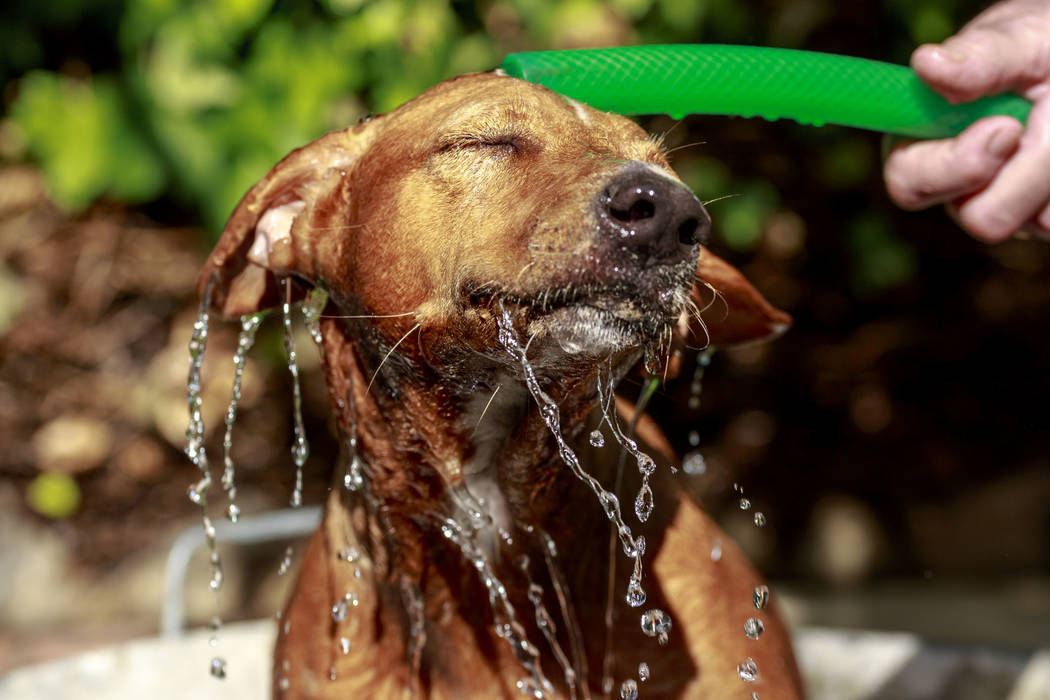
Roughly a month after the start of summer, the president of Pahrump’s Desert Haven Animal Society is offering advice to area pet owners about the brutal heat in Southern Nevada, and how it poses a lethal threat to domesticated animals.
First and foremost, Jane Carbone warned about the dangers of owners taking their pets with them while running errands about town.
“If you don’t have to bring your animals to the grocery store, you shouldn’t bring them,” she said. “The best thing to do is leave them at home because it’s just too hot. I don’t think people realize that even if they crack the windows in the car, it’s still too hot. Not only can it lead to a fatal heatstroke, it is illegal in several states.”
Last summer Nye County Sheriff’s Office deputies and animal control officers responded to several reports of owners leaving their pets inside vehicles as they went shopping.
A regular annual occurrence
Longtime Nye County Animal Control Officer Levi Gregory said each year he responds to the parking lots of area shopping centers to check on the welfare of pets locked inside cars.
As stated on the American Society for the Prevention of Cruelty to Animal (ASPCA) website, on an 85-degree day, it takes only 10 minutes for the interior of a vehicle to reach 102 degrees.
“Every summer we get calls regarding dogs being left in cars,” he said. “At 110 to 115 degrees, dogs start losing cells in their liver and their brain which can result in death for pets, and especially children with these escalating temperatures.”
Gregory also said if a dog is locked inside a hot vehicle, he has the authority to remove the animal, at the owner’s expense, and issue a citation totaling more than $600.
“They would have to pay to get the dog out of the animal shelter, as well as any vet bills that may occur as a result from the care of the animal being exposed to those kinds of conditions,” Gregory said. “We advise all pet owners, if at all possible, to leave their pets at home and not take them to the store, especially if they are going to leave them inside the vehicle while they do their shopping.”
Look for signs of distress
Carbone, meanwhile spoke of the importance of recognizing the symptoms of overheated pets.
“They include excessive panting or difficulty breathing, increased heart and respiratory rate, drooling, mild weakness, stupor or even collapsing,” she noted. “Symptoms can also include seizures, bloody diarrhea, and vomit, along with an elevated body temperature of over 104 degrees.”
Carbone also warned about the dangers of merely walking a dog during the hottest hours of the day.
“When the temperature is very high, don’t let your dog linger on hot asphalt,” she said. “Being so close to the ground, your dog’s body can heat up quickly and their sensitive paw pads can burn. You should also keep the walks to a minimum when it’s very hot outside. There are also little doggie booties to protect their feet from the heat. My advice would be to walk your dog earlier in the morning before it gets very hot outside, or walk them in the evening.”
Common sense advice
Additionally, for pet owners who do leave their pets at home while they run errands, the ASPCA website advises to provide them with plenty of fresh, clean water each day, and make sure the pets have a shady place to get out of the sun, if they are not kept indoors when it’s extremely hot.
Interestingly, the agency’s website noted that some animals are more susceptible to the dangers of heat than others.
“Animals with flat faces, like Pugs and Persian cats, are more susceptible to heatstroke since they cannot pant as effectively,” the website stated. “These pets, along with the elderly, overweight, and those with heart or lung diseases, should be kept cool in air-conditioned rooms as much as possible.”
Conversely, an at-home summertime accessory also poses dangers to pets who are kept outdoors.
“Do not leave pets unsupervised around a pool, as not all dogs are good swimmers,” the agency advised. “Introduce your pets to water gradually and make sure they wear flotation devices when on boats. Rinse your dog off after swimming to remove chlorine or salt from their fur, and try to keep your dog from drinking pool water, which contains chlorine and other chemicals.”
Human hazards
Aside from pets, Southern Nevada’s summertime temperatures naturally pose dangers to humans as well.
A group of UNLV School of Medicine surgeons recently completed a 5-year study of pavement burns when temperatures top 100 degrees.
The study noted that the pavement can get hot enough to cause second-degree burns on human skin in a matter of seconds, according to a news release from Paul Joncich, Manager of Media Relations at the UNLV School of Medicine.
“The danger is all too real for anyone who has tried to run across a convenience store parking lot in their bare feet to grab a cold drink,” the release stated. “Small children have been injured walking on hot pavement, and during our long hot summers, accident victims can suffer severe pavement burns after being thrown from motor vehicles and bicycles.”
Hot feet
Using weather data from the National Oceanic and Atmospheric Administration, researchers said they saw an exponential increase in the rate of burn admissions to hospitals as maximum ambient temperatures increased.
“While pavement burns can and do occur even when ambient temperatures are as low as 84 degrees, most pavement burns occur when the air temperature reaches 95 degrees in areas of direct sunlight, and injuries increase exponentially as temperatures rise,” the release noted. “When it’s 105 degrees or hotter, pavement in direct sunlight can cause extremely severe burns and potentially lifelong scarring.”
Contact reporter Selwyn Harris at sharris@pvtimes.com. On Twitter: @pvtimes